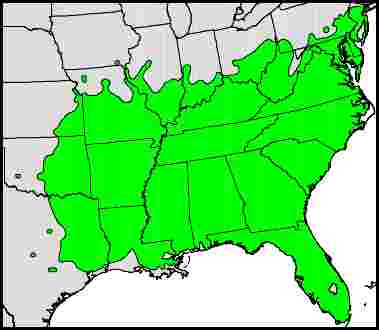American Persimmon
(Diospyros virginiana)
The genus name for the American Persimmon means "Fruit of the Gods". This is a reference to the delicious golden-orange fruits that often hang on the tree after the leaves drop in autumn. When ripe, these fruits are very sweet.
But they must be fully ripe. If you try to eat one too soon, your mouth will likely pucker from the bitter taste of tannic acid. Yet a ripe fruit is a real treat. Native Americans relished them, and they are a popular food for wild turkey, mockingbirds, deer, raccoons, foxes, squirrels, rabbits, and other wildlife. They can be made into pudding, preserves, beer, and brandy, and can also be dried for winter eating.
Most American Persimmon trees are either male or female, but some are self-fertile. The fruits are typically about one inch in diameter, though nurseries sell special cultivars which produce larger ones. The size of a crop, especially on wild trees, usually varies from year to year.
A fruit becomes soft as it ripens, and its skin begins to wrinkle. To avoid competition from wildlife, you can pick them a few days early, just after they start to soften, and let them finish ripening on a window sill. Some people say that they don't get ripe until after the first hard frost, but that isn't always true. A self-fertile variety called Meader can produce its first ripe fruit as early as mid-August in warm climates.
Although the color of this tree's fruit is normally orange, there is a rare naturally-occurring form of the species which has much darker fruit, sometimes almost black. This form is called Diospyros virginiana atra.
In addition to its fruit-bearing potential, the American Persimmon can make an attractive mid-size yard tree. The large drooping leaves give it a soft look, and the dark checkered bark of mature trees provides winter interest. The bell-shaped pistillate flowers are an appealing creamy-yellow, very fragrant, and an excellent nectar source for honeybees.
A grouping of several trees can make a good wildlife planting. The tree is tough and adaptable, grows rapidly, and its deep tap root gives it good drought resistance. It can survive in shade, but grows and fruits best in sun. Seedlings planted in good soil and a sunny location can begin fruiting in about 6-8 years.
Because wildlife distributes its seeds so effectively, American Persimmon is still fairly common in some areas. But in other regions the species is becoming scarce. A disease called persimmon wilt (Cephalsporium diospyri) has killed some wild trees in the upper South, and could spread to other areas.
Other Information
Scientific Name: Diospyros virginiana
Common Names: Persimmon, Possumwood
Plant Type: Mid-size to large deciduous tree
Height: 30 to 70 feet
Cultivation Zones: 5 - 9, though some special forms are hardy in Zone 4.
Native Habitat: Valleys and dry uplands in clearings and mixed forests
Native Range: Much of the eastern and central U.S. south of the Great Lakes region. See distribution map below.
Distribution Map

Range Map Source: U.S. Forest Service. (See General Note C)
Conservation Status: NatureServe lists Diospyros virginiana as Critically-Imperiled in Connecticut and Iowa, and Imperiled in New York. Officially the species is listed as Threatened in New Jersey and of Special Concern in Connecticut.
Cultivation: The American Persimmon can survive on poor sites, but for best growth and fruit production, give it good soil and plenty of sunlight, and keep it well-watered for the first couple of years. Spraying for insects or diseases normally isn't necessary to get good quality fruit. Because of its potentially deep tap root, a small specimen may be easier to plant.
Seeds require about three months of cold moist stratification in order to germinate. If planted in the fall, they should come up the following spring.
Go to Cultivation and Seeds for general information about planting and growing.
Related Species: The only closely related U.S. species is the Texas Persimmon (Diospyros texana), which is found in central and southern Texas and northern Mexico. Its small black fruit is edible when fully ripe, but can stain the mouth, teeth and hands. There are also a number of oriental persimmon species, some of which produce the large fruits sold in supermarkets.
Plant Sources: American persimmon trees are usually easy to obtain. For ordinary seedlings (of unknown sex), try Woodlanders, Shooting Star Nursery, Oikos Tree Crops, Elk Mountain Nursery, Musser Forests, and Nearly Native Nursery. Several plants may be required in order to get fruit.
If you want larger fruit, and want to get it sooner, you can plant one of the named varieties sold by some fruit tree nurseries. Selections include Meader, Ruby, Yates, Early Golden, and Pipher. Normally these are grafted plants, and they can begin producing a crop only three years after being planted. Note that self-fertile forms such as Meader may not produce viable seeds.
For links to the mentioned suppliers, go to Sources of Plants.
|

